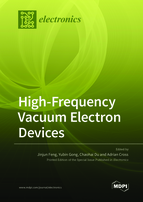High-Frequency Vacuum Electron Devices
A special issue of Electronics (ISSN 2079-9292). This special issue belongs to the section "Microelectronics".
Deadline for manuscript submissions: closed (31 December 2021) | Viewed by 33985
Special Issue Editors
Interests: millimeter wave space TWTs; W-Band TWTs; higher frequency
Special Issues, Collections and Topics in MDPI journals
Interests: MMW/THz devices
Special Issues, Collections and Topics in MDPI journals
Interests: terahertz; vacuum electronics; free electron radiation; gyrotron; plasmonics; PBG; quasi-optical antenna
Special Issue Information
Dear Colleagues,
Vacuum electron devices at frequencies of millimeter wave and terahertz play very important roles in modern system of communication, detection and imaging, etc. with the advantages of high power and high efficiency as well as compactness. The aim of the Special Issue on “High-Frequency Vacuum Electron Devices” is to enhance the exchange of research information on the theory, design, simulation and processes, to advertise the development of the devices, to promote the applications, and to attract young researchers and engineers. The scope of the Special Issue on “High-Frequency Vacuum Electron Devices” is listed below:
- Power devices including linear beam devices, cross-field devices, fast-wave devices, and others;
- Technologies and processes: microfabrication, materials, and assembly;
- Novel structures including slow wave structure, resonant structure, metastructure, hybrid structure, and others;
- Components including cathodes, electron guns, I/O systems, magnetic focusing systems and collectors, etc.
Prof. Dr. Jinjun Feng
Prof. Dr. Yubin Gong
Prof. Dr. Chaohai Du
Prof. Dr. Adrian Cross
Guest Editors
Manuscript Submission Information
Manuscripts should be submitted online at www.mdpi.com by registering and logging in to this website. Once you are registered, click here to go to the submission form. Manuscripts can be submitted until the deadline. All submissions that pass pre-check are peer-reviewed. Accepted papers will be published continuously in the journal (as soon as accepted) and will be listed together on the special issue website. Research articles, review articles as well as short communications are invited. For planned papers, a title and short abstract (about 100 words) can be sent to the Editorial Office for announcement on this website.
Submitted manuscripts should not have been published previously, nor be under consideration for publication elsewhere (except conference proceedings papers). All manuscripts are thoroughly refereed through a single-blind peer-review process. A guide for authors and other relevant information for submission of manuscripts is available on the Instructions for Authors page. Electronics is an international peer-reviewed open access semimonthly journal published by MDPI.
Please visit the Instructions for Authors page before submitting a manuscript. The Article Processing Charge (APC) for publication in this open access journal is 2400 CHF (Swiss Francs). Submitted papers should be well formatted and use good English. Authors may use MDPI's English editing service prior to publication or during author revisions.
Keywords
- millimeter wave and terahertz
- vacuum electronics
- power devices








